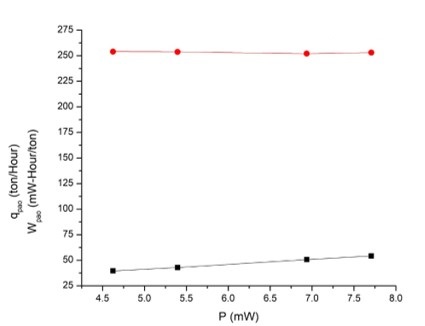Main Article Content
Abstract
Day in day out of human life the use of metal is inevitable, metals are needed for different purposes such as in construction of bridges houses, roads etc. but despite the availability of huge amount of metal, it does not meet the global demand thus this paper investigate the effect of reduction of power of heat loss on the cost of production of electric arc furnace. In order to achieve maximum precision during production, getting product at relatively reduced price has remained a major challenge to the scientists. The experiment was conducted at industrial scale whereby power of heat loss was varied from 7.707- 4.624 MW while energy consumption fell from 0.5463 to 0.5317 MW-Hour per ton and productivity q tremendously increased from 253.0 ton to 254.0 ton per hour . Data used were collected from active furnace in Zerepaves Metallurgical plant, Russia and further analyzed with software package for accuracy
Keywords
Article Details
References
- Barati, M., Esfahani, S. & Utigard, T.A. (2011). Energy recovery from high temperature slags. Energy, 36(9), 5440-5449.
- Barker, K.J., Blumenschein, C.D., Bowman, B., Chan, A.H,. Choulet, R.J. & Doran, D.J. (1998). Overview of steelmaking processes and their development. Fruehan RJ (ed) The making, shaping and treating of the steel. The AISE steel Foundation , Pitsburgh.
- Bekker, J.G., Craig, I.K. & Pistorius, P.C. (2000). Model predictive control of an electric arc furnace off-gas process. Control Engineering Practice, 8(4), 445-455.
- Bisio, G., Rubatto, G. & Martini, R. (2000). Heat transfer , energy saving and pollution control in UHP electric –arc furnaces. Energy, 25(11), 1047-1066. https://doi.org .10.1016/SO360-5442(00)00037-2.
- Carlsson, L. Samuelsson, P. & Jonson, P. (2019) Predicting the electrical energy consumption of electricarc furnaces using statistical modelling. Metals, 9(9). https://doi.org. 10/3390.met9090959.
- Chen, C., Liu, Y., Kumar, M. & Qin, J, (2018). Energy consumption Modelling using deep leaning technique — a case study of EAF. Procedia CIRP, 72, 1063-1068. https.doi.org.10.1016.J. procir.2018.03.095.
- Egorov, A.V. (1990). Calculation of power and parameters of electric furnace of black metallurgy A.V. Egorov , Moscow, Metallurgy.
- Fathi, A. & Saboohi, Y. & Logar, V. (2015). Low Computational-complexity Model of EAF Arc-heat Distribution. ISIJ International, 55(7). 1353-1360. 10.2355/isijinternational.55.1353
- Gandt, K., Meier, T., Echterhof, T. & Pfeifer, H. (2016) Heat recovery from EAF off-gas for steam generation. Analytical energy study of a sample EAF batch. Ironmak Steelmak, 43(8), 1-7. https://doi.org.10.1080/03019233.2016.1155812.
- International Energy Agency (IEA) world Energy outlook (2014). IEA publications. https://www.iea.org/reports/world-energy-outlook-2014.
- Kirschen ,M., Risonarta, V. & Pfeifer, H. (2008). Energy efficiency and the influence of gas burners to the energy related carbon dioxide emissions of electric arc furnaces in steel industry. Energy, 34(9), 1065-1072. https://doi.org.10.1016/.J.energy.2009.04.015.
- Kovacic, M.,Stopar, K., Vertnik, R. & Sarler, B. ( 2019) Comprehensive electric arc furnace electric energy consumption modeling. A pilot study. Energies, 12(11). https://doi.org.10./3390.en12112142.
- Lee, B., Ryu, J.W. & Sohn, I. (2014). Effect of hot metal utilization on the steelmaking process parameters in the electric arc furnace. Steel Research International, 86(3), 302-309. https://doi.org.10.1002//srin.201400157.
- Lee, B. & Sohn, I. (2014). Review of innovative energy savings technology for the electric arc furnace. JOM, 66(9), 1581-1594. https://Doi.org/10.1007/.s11837/-014-1092-y.
- Leon-Munizaga N., Aguirre-Munizaga, M., Lagos-Ortiz, K. & Ciopppo-Morstadt, J.D. (2020). Prediction of energy consumption in an electric arc furnace using Weka. Proceeding of the 6th International Conference on Communications in computer and information science. Guayaquil, Ecuador. p58-70.
- Logar, V., Dovzan, D. & Skrjanc, I. (2012a). Modeling and Validation of an Electric Arc Furnace: Part 1, Heat and Mass Transfer. ISIJ International, 52. 402-412. 10.2355/isijinternational52. 402
- Logar, V., Dovzan, D. & Skrjanc, I (2012b). Modeling and Validation of an Electric Arc Furnace: Part 2, Thermo-chemistry. ISIJ International, 52, 413-423. 10.2355/isijinternational52.413
- Logar, V. & Skrjanc, I. (2012c). Modeling and Validation of the Radiative Heat Transfer in an Electric Arc Furnace. ISIJ International, 52, 1225-1232. 10.2355/isijinternational52.1225
- MacRosy, R.D.M. & Swatz, C.L.E. (2005). Dynamic modeling of an industrial electric arc furnace. Industrial & Engineering Chemistry Research, 44(31), 8067-8083. http://doi.org .1o.1021/.ie050101b.
- Oosthuizen, D.J.,Craig, I.K. & Pistorius, P.C. (2004) Economic evaluation and design of an electric arc furnace controller based on economic objectives. Control Engineering Practice, 12(3), 253-265. https://doi.org/10.1016/S0967-0661(03)00078-9.
- Saboohi, Y., Fathi, A. & Logar, V. (2017). Additional slag doors for increased eaf efficiency: a conceptual study. ISIJ International, 57. 1394-1399. 10.2355/isijinternational.ISIJINT-2017-128.
- Saboohi, Y., Fathi, A., Skrajanc, I. & Logar, V. (2018). IEEE Transactions on Industrial Electronics, 66(10), 8030 -8039. https://doi.org. 10.1109/TIE.2018.2883247.
